Crank J. Free and Moving Boundary Problems
Подождите немного. Документ загружается.

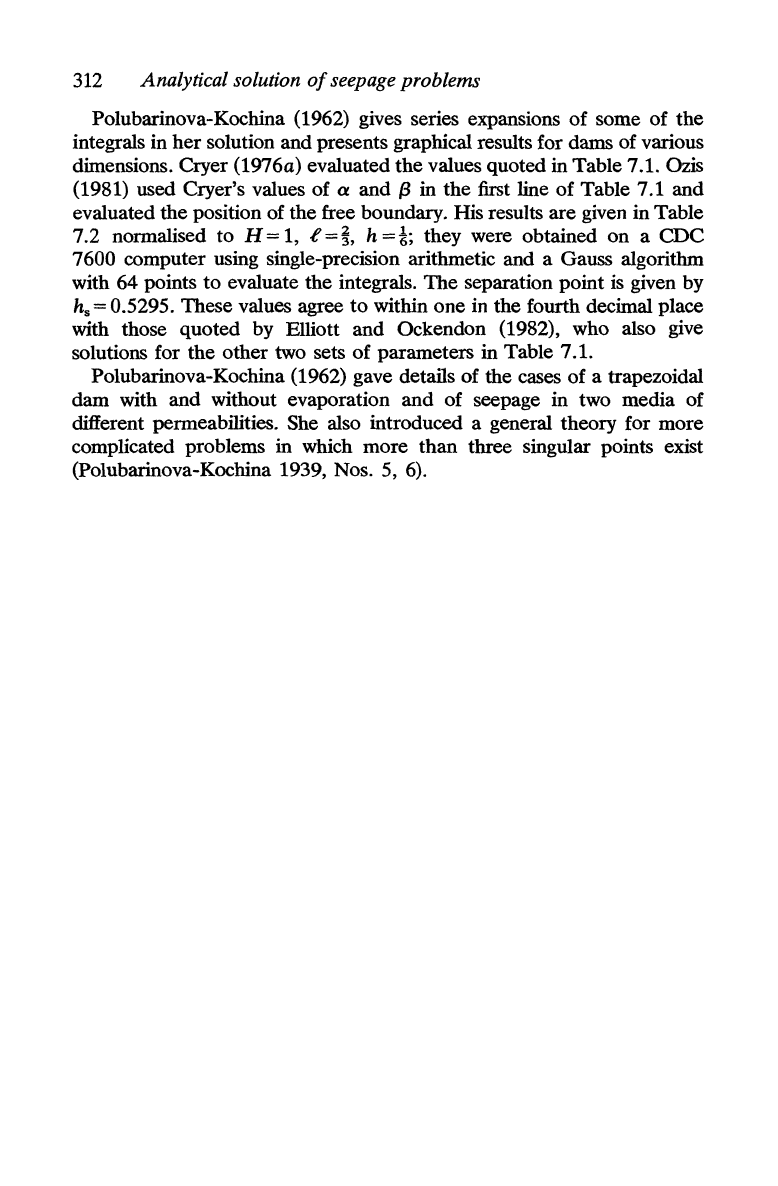
312
Analytical solution
of
seepage problems
Polubarinova-Kochina (1962) gives series expansions of some of the
integrals in
her
solution and presents graphical results for dams of various
dimensions. Cryer
(1976a) evaluated
the
values quoted in Table 7.1. Ozis
(1981) used Cryer's values of
a and
(3
in the first line
of
Table 7.1 and
evaluated the position of the free boundary. His results are given in Table
7.2 normalised to
H = 1, e
=~,
h = i; they were obtained on a
CDC
7600 computer using single-precision arithmetic and a Gauss algorithm
with 64 points to evaluate the integrals.
The
separation point
is
given by
h. = 0.5295. These values agree
to
within one
in
the fourth decimal place
with those quoted by Elliott and Ockendon (1982), who also give
solutions for the other two sets of parameters in Table 7.1.
Polubarinova-Kochina (1962) gave details of the cases of a trapezoidal
dam with and without evaporation
and
of seepage in two media of
different permeabilities. She also introduced a general theory for more
complicated problems in which more than three singular points exist
(Polubarinova-Kochina 1939, Nos. 5, 6).
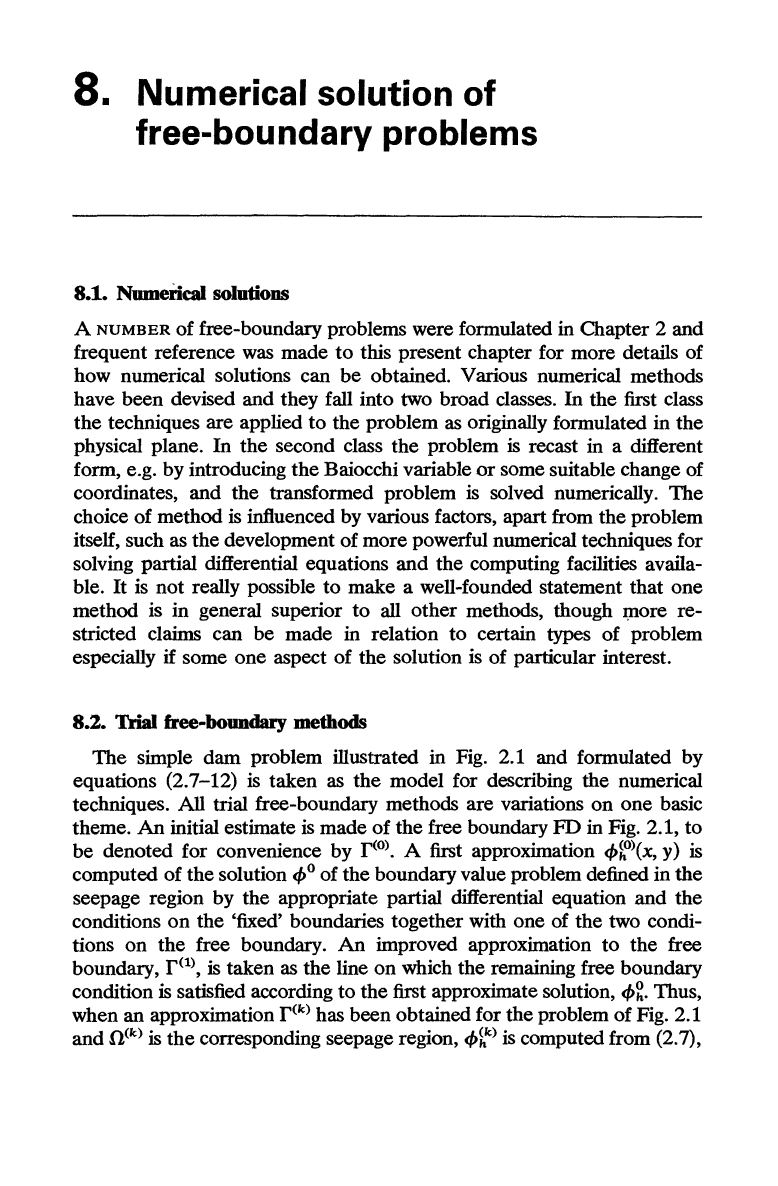
8.
Numerical solution of
free-boundary problems
8.1.
Numerical solutions
A
NUMBER
of
free-boundary problems were formulated in Chapter 2 and
frequent reference was made
to
this present chapter for more details of
how numerical solutions can
be
obtained. Various numerical methods
have been devised and they fall into two broad classes.
In
the first class
the
techniques are applied to the problem as originally formulated in the
physical plane.
In the second class the problem is recast in a different
form, e.g. by introducing
the
Baiocchi variable
or
some suitable change of
coordinates, and the transformed problem
is solved numerically.
The
choice
of
method is influenced by various factors, apart from the problem
itself, such as the development
of
more powerful numerical techniques for
solving partial differential equations
and
the computing facilities availa-
ble.
It
is
not
really possible to make a well-founded statement that
one
method is in general superior to all
other
methods, though
I:Dore
re-
stricted claims can be made in relation to certain types
of
problem
especially
if
some
one
aspect
of
the solution is of particular interest.
8.2. Trial free-boundary methods
The
simple
dam
problem illustrated in Fig. 2.1 and formulated by
equations (2.7-12)
is taken as
the
model for describing the numerical
techniques. All trial free-boundary methods are variations
on
one
basic
theme.
An
initial estimate
is
made
of
the free boundary
FD
in Fig. 2.1, to
be
denoted for convenience by
reO).
A first approximation
<f>~O)(x,
y)
is
computed
of
the solution
<f>
0
of
the boundary value problem defined in the
seepage region by the appropriate partial differential equation and the
conditions
on
the 'fixed' boundaries together with one of the two condi-
tions
on
the free boundary.
An
improved approximation to the free
boundary,
r(l),
is taken as the line
on
which the remaining free boundary
condition is satisfied according to the first approximate solution,
<f>~.
Thus,
when
an
approximation
r(k)
has been obtained for the problem
of
Fig. 2.1
and
n(k) is
the
corresponding seepage region,
<f>~k)
is computed from (2.7),
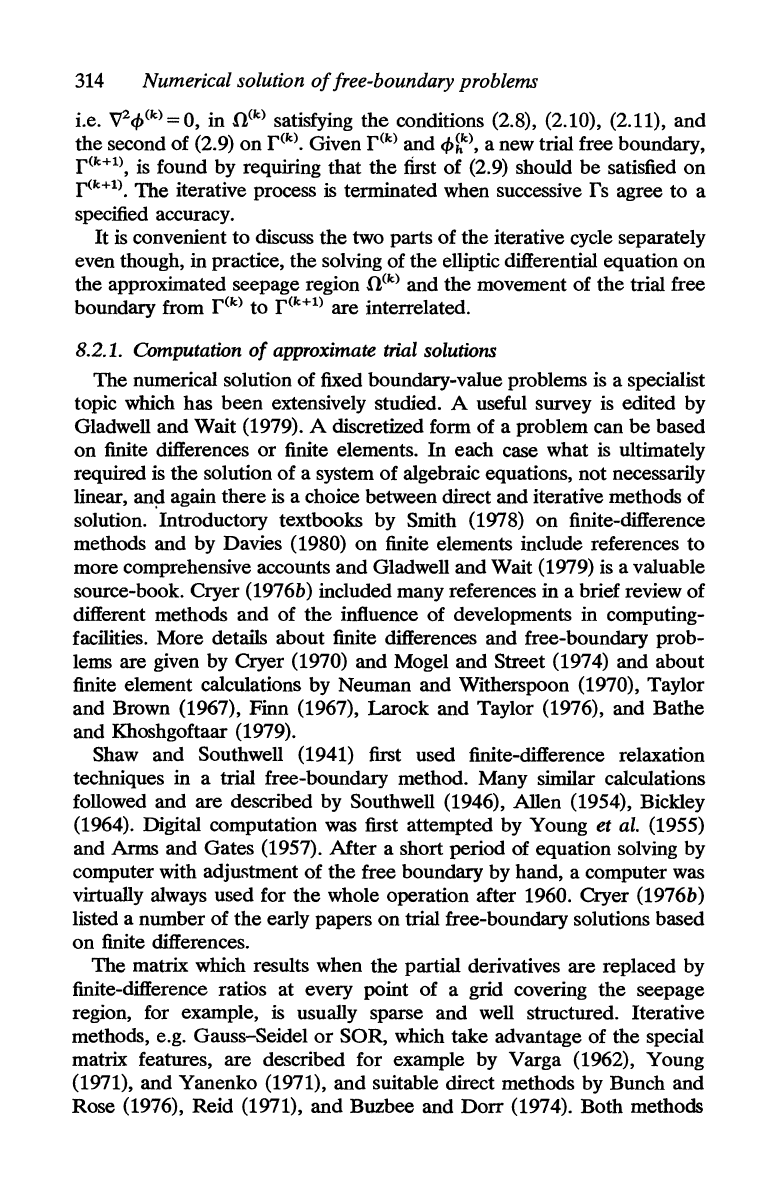
314
Numerical solution
of
free-boundary problems
i.e. V
2
<t>(k)
=0,
in
n(k)
satisfying
the
conditions (2.8), (2.10), (2.11), and
the
second
of
(2.9)
on
r(k). Given r(k) and
<t>~k>,
a new trial free boundary,
r(k+l), is found by requiring that
the
first of (2.9) should
be
satisfied
on
r(k+l).
The
iterative process
is
terminated when successive
rs
agree
to
a
specified accuracy.
It
is convenient
to
discuss
the
two parts
of
the
iterative cycle separately
even though, in practice, the solving
of
the elliptic differential equation
on
the
approximated seepage region
n(k)
and the movement
of
the
trial free
boundary from r(k)
to
r(k+l) are interrelated.
8.2.1. Computation
of
approximate trial solutions
The
numerical solution
of
fixed boundary-value problems is a specialist
topic which has been extensively studied. A useful survey is edited by
Gladwell and Wait (1979). A discretized form of a problem can
be
based
on
finite differences
or
finite elements.
In
each case what is ultimately
required is the solution
of
a system
of
algebraic equations, not necessarily
linear, and again there is a choice between direct and iterative methods of
solution. 'Introductory textbooks by Smith (1978)
on
finite-difference
methods and by Davies (1980)
on
finite elements include references
to
more comprehensive accounts
and
Gladwell and Wait (1979) is a valuable
source-book. Cryer
(1976b) included many references in a brief review
of
different methods and
of
the
influence
of
developments in computing-
facilities.
More
details about finite differences and free-boundary prob-
lems are given by Cryer (1970) and Mogel and Street (1974) and about
finite element calculations by Neuman and Witherspoon (1970), Taylor
and Brown (1967), Finn (1967), Larock and Taylor (1976), and
Bathe
and Khoshgoftaar (1979).
Shaw and Southwell (1941) first used finite-difference relaxation
techniques in a trial free-boundary method. Many similar calculations
followed and are described by Southwell (1946), Allen (1954), Bickley
(1964). Digital computation was first attempted by Young
et al. (1955)
and Arms and Gates (1957).
After
a short period of equation solving by
computer with
adju.<;tment
of
the
free boundary by hand, a computer was
virtually always used for
the
whole operation after 1960. Cryer (1976b)
listed a number of
the
early papers
on
trial free-boundary solutions based
on
finite differences.
The
matrix which results when the partial derivatives are replaced by
finite-difference ratios
at
every point of a grid covering
the
seepage
region, for example, is usually sparse and well structured. Iterative
methods, e.g. Gauss-Seidel
or
SOR, which take advantage of the special
matrix features, are described for example by Varga (1962), Young
(1971), and Yanenko (1971),
and
suitable direct methods by Bunch and
Rose (1976), Reid (1971),
and
Buzbee and
Dorr
(1974).
Both
methods
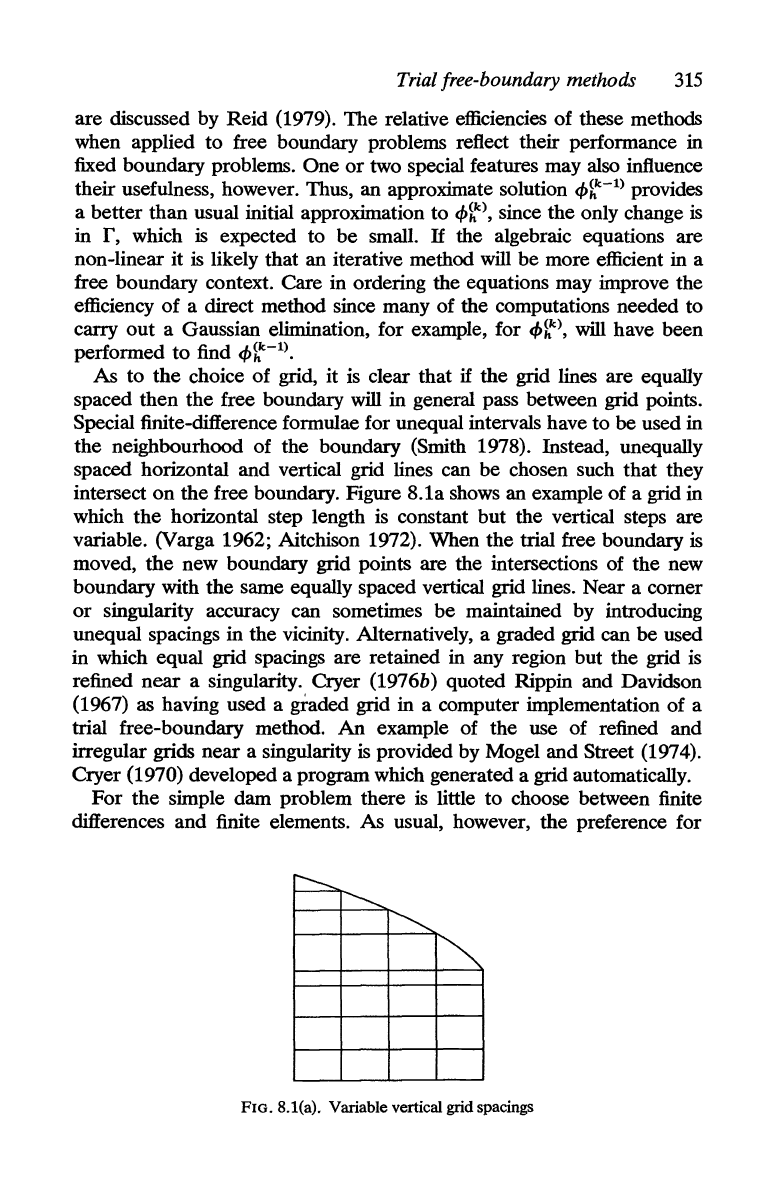
Trial free-boundary methods
315
are discussed by Reid (1979). The relative efficiencies of these methods
when applied to free boundary problems reflect their performance in
fixed boundary problems.
One
or
two special features may also influence
their usefulness, however. Thus, an approximate solution
cf>~k-l)
provides
a better than usual initial approximation to
cf>~k),
since the only change
is
in r, which
is
expected to
be
smalI. H the algebraic equations are
non-linear it
is
likely that an iterative method will be more efficient in a
free boundary context. Care in ordering the equations may improve the
efficiency
of
a direct method since many of the computations needed to
carry out a Gaussian elimination, for example, for
cf>~k>,
will have been
performed
to
find
cf>~k-l).
As
to
the
choice of grid, it
is
clear that
if
the grid lines are equally
spaced then
the
free boundary will in general pass between grid points.
Special finite-difference formulae for unequal intervals have to be used in
the neighbourhood of the boundary (Smith 1978). Instead, unequally
spaced horizontal and vertical grid lines can be chosen such that they
intersect on the free boundary. Figure 8.1a shows an example of a grid in
which
the
horizontal step length is constant but the vertical steps are
variable. (Varga 1962; Aitchison 1972). When the trial free boundary
is
moved,
the
new boundary grid points are the intersections of the new
boundary with the same equally spaced vertical grid lines. Near a corner
or singularity accuracy can sometimes be maintained by introducing
unequal spacings in the vicinity. Alternatively, a graded grid can be used
in which equal grid spacings are retained in any region but the grid
is
refined
near
a singularity. Cryer (1976b) quoted Rippin and Davidson
(1967) as having used a graded grid in a computer implementation of a
trial free-boundary method.
An
example of the use of refined and
irregular grids near a singularity
is
provided by Mogel and Street (1974).
Cryer (1970) developed a program which generated a grid automatically.
For
the simple dam problem there
is
little to choose between finite
differences and finite elements. As usual, however, the preference for
L::::::"
...............
~
~
FIG.8.1(a). Variable vertical grid spacings
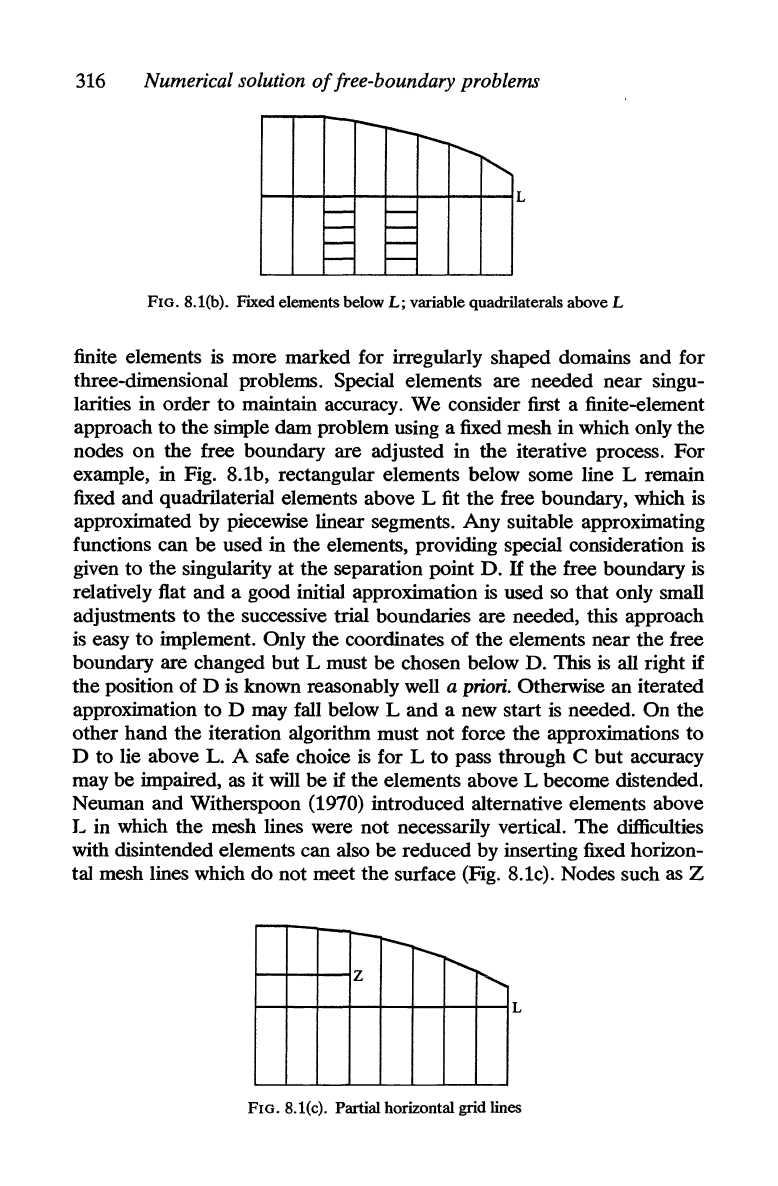
316
Numerical solution
of
free-boundary problems
FIG. 8.1(b). Fixed elements below
L;
variable quadrilaterals above L
finite elements is more marked for irregularly shaped domains
and
for
three-dimensional problems. Special elements are
needed
near
singu-
larities in
order
to
maintain accuracy.
We
consider first a finite-element
approach
to
the
simple
dam
problem using a fixed mesh in which only
the
nodes
on
the
free boundary are adjusted in
the
iterative process.
For
example, in Fig. 8.1b, rectangular elements below some line L remain
fixed
and
quadrilaterial elements above L fit
the
free boundary, which is
approximated by piecewise linear segments.
Any
suitable approximating
functions can
be
used in
the
elements, providing special consideration is
given
to
the
singularity
at
the
separation point
D.
If
the
free boundary is
relatively fiat
and
a good initial approximation is used so
that
only small
adjustments
to
the
successive trial boundaries
are
needed, this approach
is easy
to
implement. Only
the
coordinates
of
the
elements
near
the
free
boundary are changed
but
L must
be
chosen below
D.
This
is
all right
if
the
position of D is known reasonably well a
priori.
Otherwise
an
iterated
approximation
to
D may fall below L
and
a new start is needed.
On
the
other
hand
the
iteration algorithm must
not
force
the
approximations
to
D
to
lie above L. A safe choice is for L
to
pass through C
but
accuracy
may
be
impaired, as it will
be
if
the
elements above L become distended.
Neuman
and
Witherspoon (1970) introduced alternative elements above
L in which
the
mesh lines were
not
necessarily vertical.
The
difficulties
with disintended elements can also
be
reduced by inserting fixed horizon-
tal mesh lines which
do
not
meet
the
surface (Fig. 8.1c). Nodes such as Z
r--r--
""'"-
z
i"'-...r'"
........
L
FIG. 8.1(c). Partial horizontal grid lines
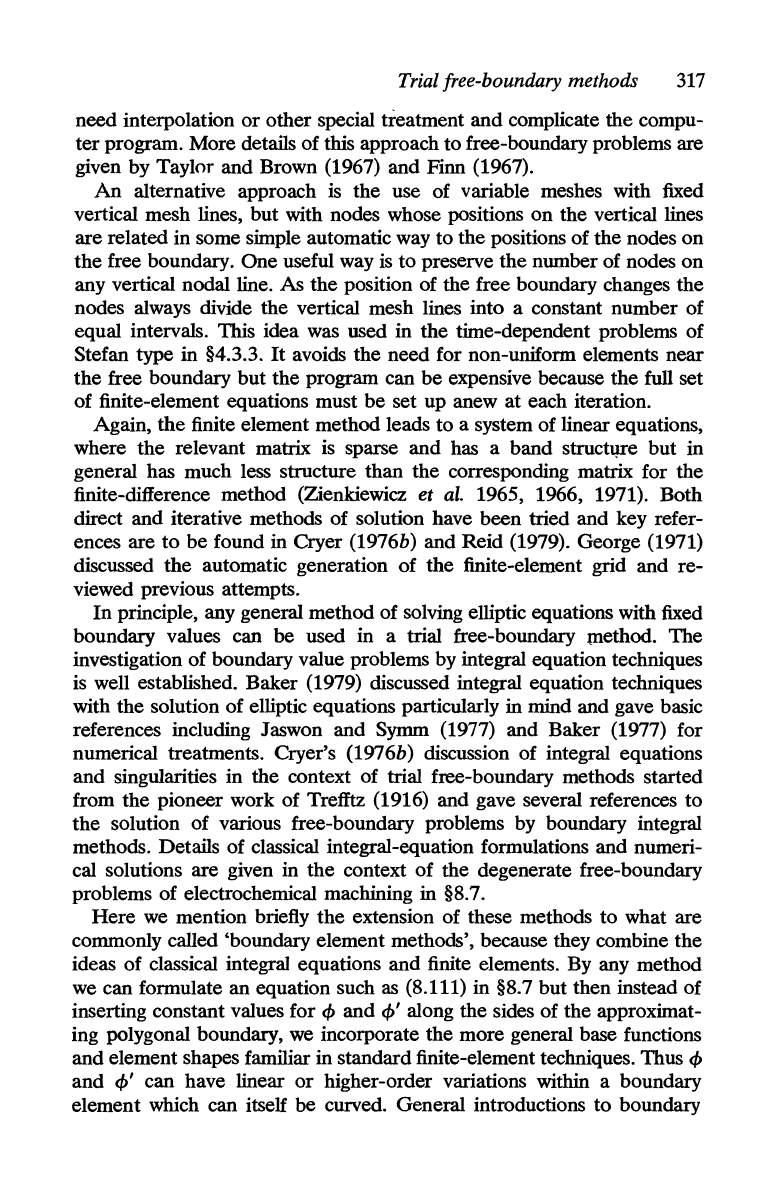
Trial free-boundary methods
317
need
interpolation
or
other
special treatment
and
complicate
the
compu-
ter
program. More details
of
this approach
to
free-boundary problems are
given
by
Taylor
and
Brown (1967) and Finn (1967).
An
alternative approach is
the
use
of
variable meshes with fixed
vertical mesh lines,
but
with nodes whose positions
on
the
vertical lines
are
related
in
some simple automatic way
to
the
positions
of
the
nodes
on
the
free boundary.
One
useful way is
to
preserve
the
number
of
nodes
on
any vertical nodal line.
As
the
position
of
the
free boundary changes
the
nodes always divide
the
vertical mesh lines into a constant
number
of
equal intervals. This idea was used in
the
time-dependent problems
of
Stefan type
in
§4.3.3.
It
avoids
the
need
for non-uniform elements
near
the
free boundary
but
the
program can
be
expensive because
the
full set
of
finite-element equations must
be
set
up
anew
at
each iteration.
Again,
the
finite element method leads
to
a system
of
linear equations,
where
the
relevant matrix is sparse
and
has a
band
structqre
but
in
general has much less structure
than
the
corresponding matrix for
the
finite-difference method (Zienkiewicz et
al.
1965, 1966, 1971).
Both
direct
and
iterative methods
of
solution have
been
tried
and
key refer-
ences are
to
be
found in Cryer (1976b)
and
Reid
(1979). George (1971)
discussed
the
automatic generation
of
the
finite-element grid
and
re-
viewed previous attempts.
In
principle, any general method
of
solving elliptic equations with fixed
boundary values can
be
used in a trial free-boundary method.
The
investigation
of
boundary value problems by integral equation techniques
is well established.
Baker
(1979) discussed integral equation techniques
with
the
solution
of
elliptic equations particularly in mind
and
gave basic
references including Jaswon
and
Symm (1977)
and
Baker
(1977) for
numerical treatments. Cryer's (1976b) discussion
of
integral equations
and
singularities in
the
context
of
trial free-boundary methods started
from
the
pioneer work
of
Trefftz (1916)
and
gave several references
to
the
solution
of
various free-boundary problems by boundary integral
methods. Details
of
classical integral-equation formulations and numeri-
cal solutions are given in
the
context
of
the
degenerate free-boundary
problems
of
electrochemical machining in §S.7.
Here
we mention briefly
the
extension
of
these methods
to
what are
commonly called 'boundary element methods', because they combine
the
ideas
of
classical integral equations
and
finite elements. By any method
we can formulate
an
equation such as (S.111)
in
§S.7
but
then instead
of
inserting constant values for
<p
and
<P'
along
the
sides
of
the
approximat-
ing polygonal boundary, we incorporate
the
more
general base functions
and
element shapes familiar in standard finite-element techniques. Thus
<p
and
<P'
can have linear
or
higher-order variations within a boundary
element which can itself
be
curved. General introductions
to
boundary
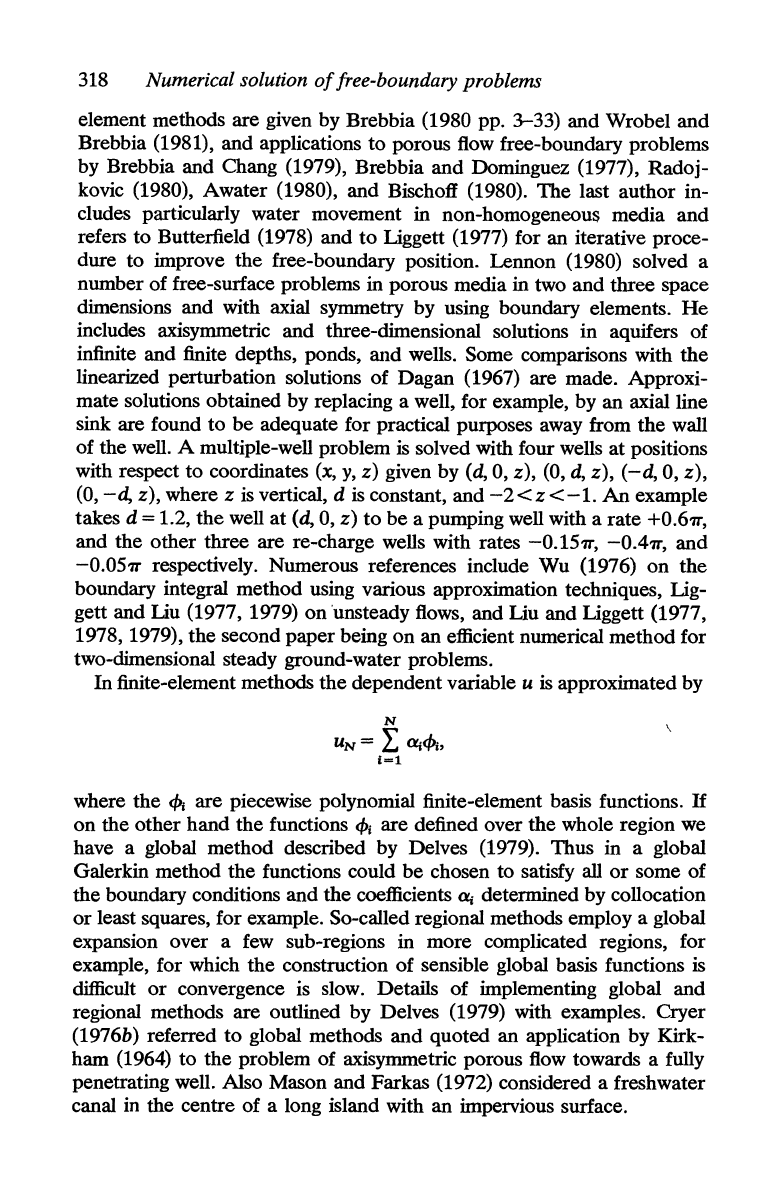
318
Numerical solution
of
free-boundary problems
element methods are given by Brebbia (1980 pp. 3-33) and Wrobel
and
Brebbia (1981), and applications to porous flow free-boundary problems
by Brebbia and Chang
(1979), Brebbia and Dominguez (1977), Radoj-
kovic
(1980), Awater (1980), and Bischoff (1980). The last author in-
cludes particularly water movement in non-homogeneous media and
refers to Butterfield
(1978) and
to
Liggett (1977) for an iterative proce-
dure to improve the free-boundary position. Lennon
(1980) solved a
number of free-surface problems in porous media in two and three space
dimensions and with axial symmetry by using boundary elements.
He
includes axisymmetric and three-dimensional solutions in aquifers of
infinite and finite depths, ponds, and wells. Some comparisons with
the
linearized perturbation solutions of Dagan (1967) are made. Approxi-
mate solutions obtained by replacing a well, for example, by an axial line
sink are found to
be
adequate for practical purposes away from the wall
of the well. A multiple-well problem is solved with four wells
at
positions
with respect to coordinates
(x,
y, z) given by
(d,
0, z), (0,
d,
z),
(-d,
0, z),
(0,
-d,
z), where z is vertical, d is constant, and
-2<z<-1.
An
example
takes
d = 1.2,
the
well
at
(d, 0, z)
to
be a pumping well with a rate +0.6'IT,
and the other three are re-charge wells with rates -O.lS'IT, -0.4'IT, and
-O.OS'IT
respectively. Numerous references include Wu (1976) on
the
boundary integral method using various approximation techniques, Lig-
gett and Liu
(1977, 1979) on unsteady flows, and Liu and Liggett (1977,
1978, 1979),
the second paper being on an efficient numerical method for
two-dimensional steady ground-water problems.
In
finite-element methods the dependent variable u is approximated by
where the
cf>i
are piecewise polynomial finite-element basis functions.
If
on the other hand the functions
cP;
are defined over the whole region we
have a global method described by Delves
(1979). Thus in a global
Galerkin method the functions could be chosen to satisfy all
or
some of
the boundary conditions and the coefficients
a; determined by collocation
or least squares, for example. So-called regional methods employ a global
expansion over a few sub-regions in more complicated regions, for
example, for which the construction of sensible global basis functions
is
difficult
or
convergence is slow. Details of implementing global and
regional methods are outlined by Delves
(1979) with examples. Cryer
(1976b) referred
to
global methods
and
quoted an application by Kirk-
ham
(1964) to the problem of axisymmetric porous flow towards a fully
penetrating well. Also Mason and Farkas
(1972) considered a freshwater
canal
in
the centre of a long island with an impervious surface.
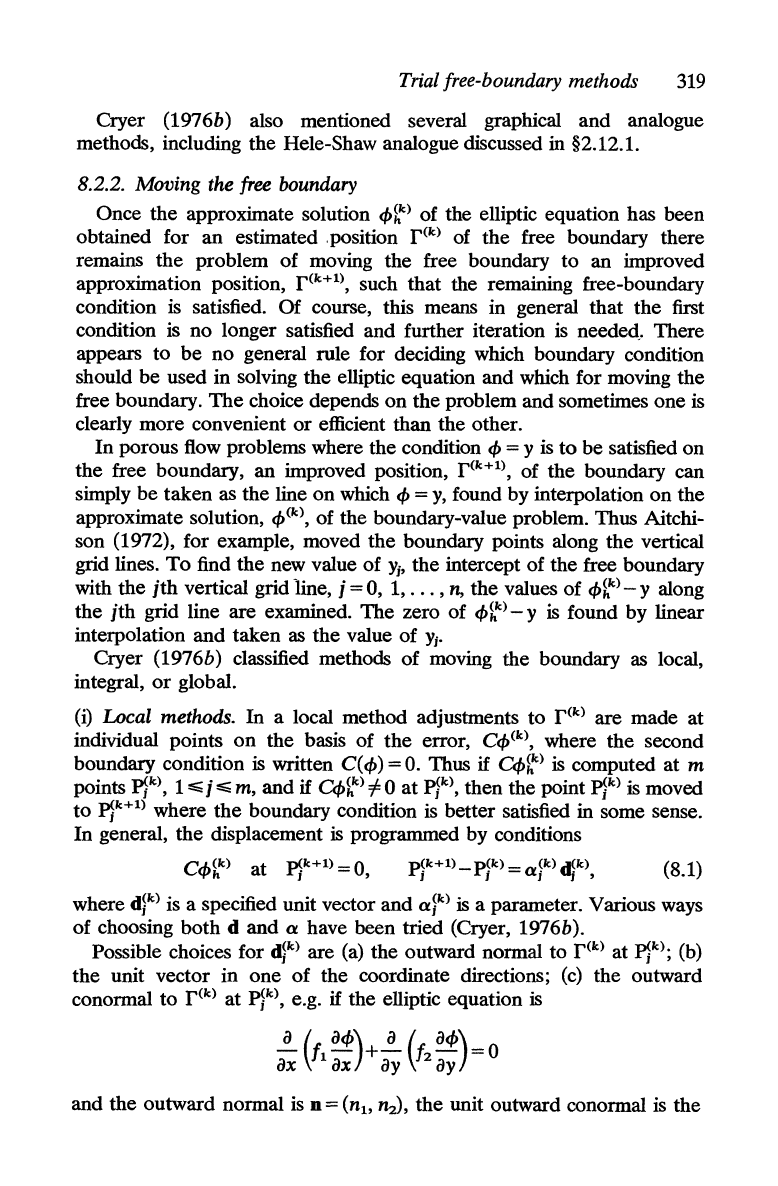
Trial free-boundary methods
319
Cryer (1976b) also mentioned several graphical
and
analogue
methods, including the Hele-Shaw analogue discussed in §2.12.1.
8.2.2. Moving the
free
boundary
Once
the
approximate solution
</>~k)
of the elliptic equation has been
obtained for
an
estimated ,position
r(k)
of
the
free boundary there
remains
the
problem of moving the free boundary
to
an improved
approximation position,
r(k+1),
such that the remaining free-boundary
condition is satisfied.
Of
course, this means in general
that
the
first
condition is no longer satisfied and further iteration is
needed__
There
appears
to
be
no general rule for deciding which boundary condition
should
be
used in solving
the
elliptic equation and which for moving
the
free boundary.
The
choice depends
on
the
problem and sometimes one is
clearly
more
convenient
or
efficient than
the
other.
In
porous flow problems where the condition
</>
= y is
to
be satisfied on
the free boundary,
an
improved position,
r(k+l),
of
the
boundary can
simply
be
taken
as the line
on
which
</>
=
y,
found by interpolation
on
the
approximate solution,
</>(k),
of the boundary-value problem. Thus Aitchi-
son (1972), for example, moved
the
boundary points along
the
vertical
grid lines.
To
find
the
new value of
Yj'
the
intercept of the free boundary
with the
jth
vertical grid line, j = 0, 1,
...
,
n,
the
values
of
</>~k)
- Y along
the
jth
grid line are examined.
The
zero
of
</>~k)
- Y
is
found by linear
interpolation
and
taken as
the
value of
Yj.
Cryer (1976b) classified methods
of
moving the boundary
as
local,
integral,
or
global.
(i)
Local methods.
In
a local method adjustments
to
r(k)
are made at
individual points
on
the basis
of
the
error,
C</>(k>,
where
the
second
boundary condition
is written
C(
</»
=
O.
Thus
if
ap~k)
is
computed at m
points
11
k
),
l~j~m,
and
if
ap~k)fO
at
11
k
),
then the point
11
k
)
is moved
to
I1k+l)
where
the
boundary condition is better satisfied in some sense.
In
general,
the
displacement is programmed by conditions
CA..(h
k
) at
p,k+l)
= 0
p(k+l)
-
p(k)
=
a(k)
d(k)
(8.1)
'I'
J , J J J
I'
where dJk) is a specified unit vector
and
aJk) is a parameter. Various ways
of choosing
both
d
and
a have been tried (Cryer, 1976b).
Possible choices for
dJk)
are (a) the outward normal
to
r(k)
at
11
k
);
(b)
the
unit vector in one
of
the coordinate directions;
(c)
the outward
conormal
to
r(k)
at
11
k
),
e.g.
if
the elliptic equation is
~
(fl
a</»+~
(f2
a</»
= 0
ax ax
ay ay
and
the
outward normal is n =
(n!>
n~,
the
unit outward conormal is
the
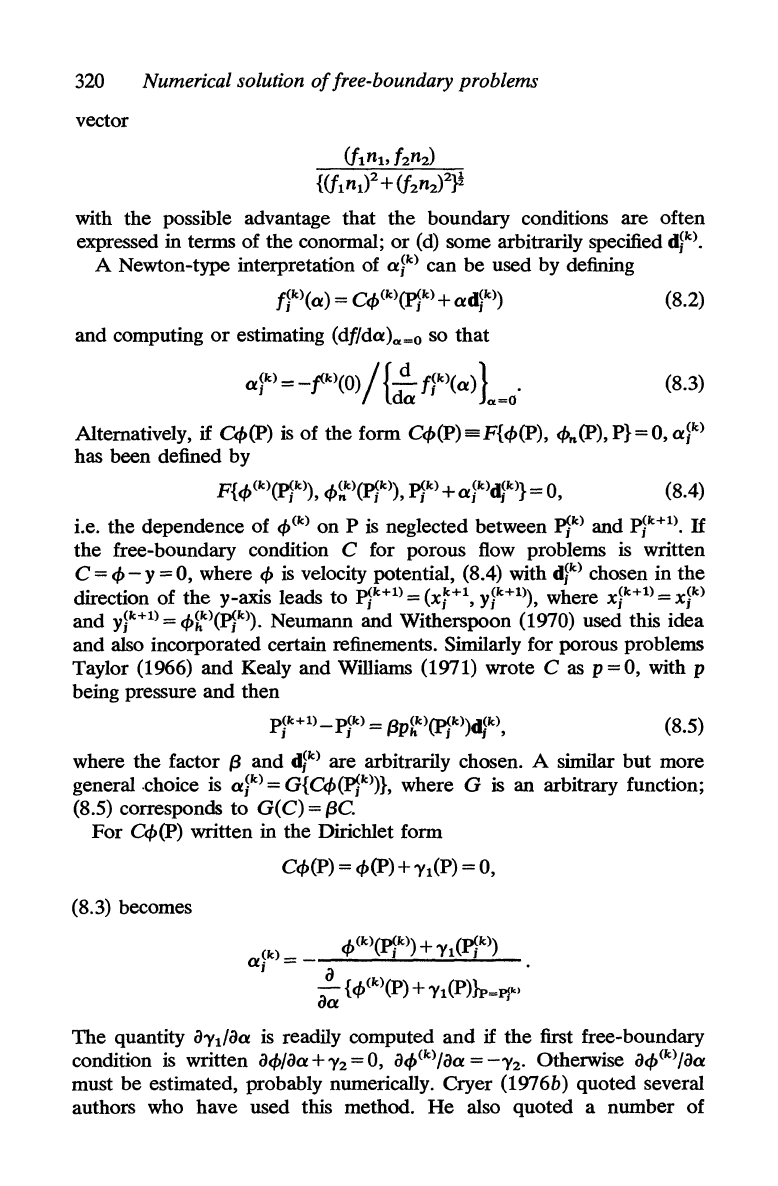
320
Numerical solution
of
free-boundary problems
vector
{(flnl)2+
(f2n2)2)!
with
the
possible advantage
that
the
boundary conditions
are
often
expressed in
tenns
of
the
conormal;
or
(d) some arbitrarily specified
dfk).
A Newton-type interpretation of
afk)
can
be
used by defining
f}k)(a) =
Gp(k)CI1k)
+
ad}k»)
(8.2)
and
computing
or
estimating (df/da)",=o so
that
a~k)
=
-fk)(O)/
{~f}k)(a)}
. (8.3)
da
«=0
Alternatively,
if
G/>(P) is
of
the
form Gp(P)=F{</>(p),
</>n(P),
P}=O, a}k)
has been defined
by
(8.4)
i.e.
the
dependence of
</>(k)
on
P is neglected between
Pfk)
and
p}k+1).
If
the
free-boundary condition C for porous flow problems is written
C =
</>
- y =
0,
where
</>
is
velocity potential, (8.4) with
dfk)
chosen in
the
direction
of
the
y-axis leads
to
Pfk+l)
=
(xf+\
y~k+1»),
where
X}k+l)
=
X}k)
and
y}k+l) =
</>~k)(~k»).
Neumann
and
Witherspoon (1970) used this
idea
and
also incorporated certain refinements. Similarly for porous problems
Taylor (1966)
and
Kealy
and
Williams (1971) wrote C as p = 0, with p
being pressure
and
then
p}k+1)_
p~k)
=
(3p~k)CI1k»)djk>,
(8.5)
where
the
factor
(3
and
djk)
are
arbitrarily chosen. A similar
but
more
general .choice is ajk) =
G{c<p(~k»)},
where G is
an
arbitrary function;
(8.5) corresponds
to
G(C)
= (3c.
For
C</>(p)
written in
the
Dirichlet form
C</>(p)
=
</>(P)
+
'Yl(P)
= 0,
(8.3) becomes
0:
{</>(k)(p)
+
'Yl
(P)}P=I1k)
The
quantity
O'Yl/oa
is readily computed
and
if
the
first free-boundary
condition is written o</>/oa+'Y2=0, o</>(k)/oa=-'Y2. Otherwise
o</>(k)/oa
must
be
estimated, probably numerically. Cryer (1976b) quoted several
authors who
have
used this method.
He
also
quoted
a
number
of
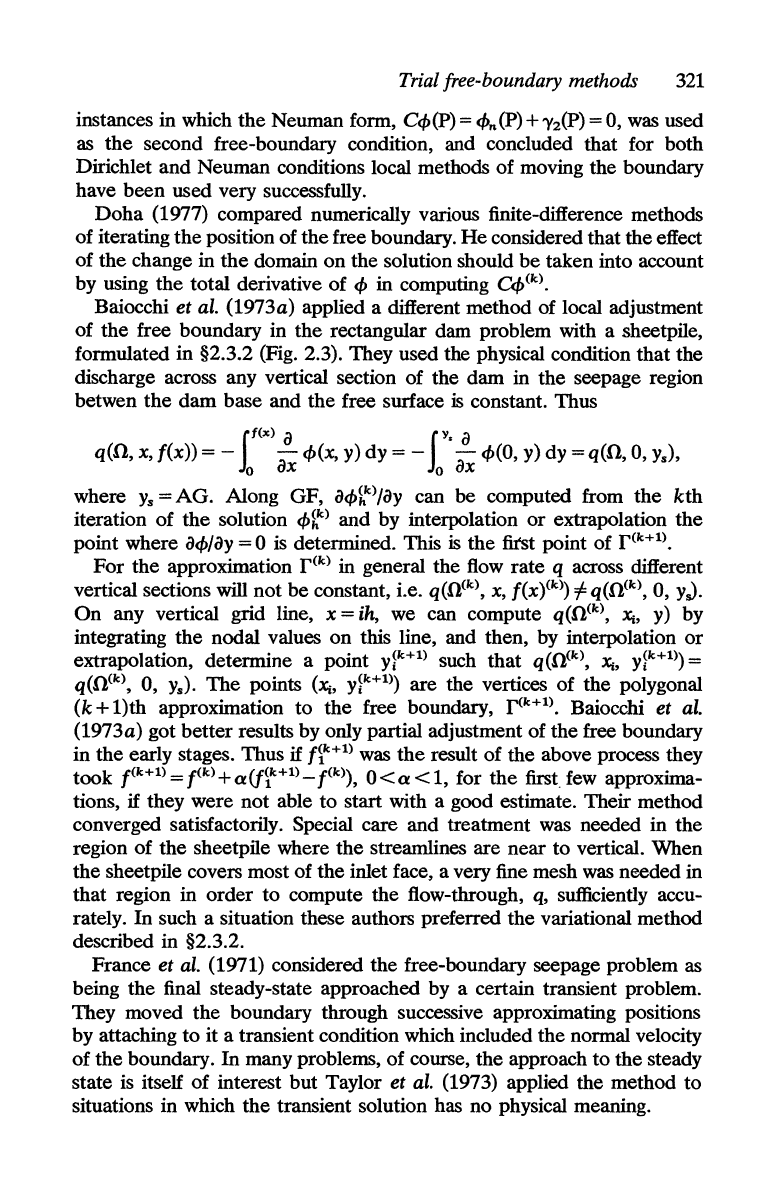
Trial free-boundary methods
321
instances in which the Neuman form,
C<I>(P)
=
<I>n
(P)
+
'Y2(P)
= 0, was used
as
the
second free-boundary condition, and concluded that for both
Dirichlet and Neuman conditions local methods of moving the boundary
have been used very successfully.
Doha
(1977) compared numerically various finite-difference methods
of iterating the position of the free boundary.
He
considered that the effect
of
the
change in
the
domain
on
the solution should
be
taken into account
by using the total derivative
of
<I>
in computing
C<f>(k).
Baiocchi
et
al. (1973a) applied a different method of local adjustment
of
the free boundary in
the
rectangular dam problem with a sheetpile,
formulated in §2.3.2 (Fig. 2.3). They used the physical condition
that
the
discharge across any vertical section
of
the dam in the seepage region
betwen
the
dam
base and the free surface is constant. Thus
I
f(X)
a
lY'
a
q(O,
x, f(x)) = - -
<I>
(x, y)
dy
= - -
<1>(0,
y)
dy
=q(O,
0,
Ys),
o
ax
0
ax
where
y.
=
AG.
Along GF,
a<l>~k)/ay
can
be
computed from the
kth
iteration
of
the
solution
<I>~k)
and by interpolation
or
extrapolation the
point where
a<l>lay
= °
is
determined. This is the fitst point
of
r(k+l).
For
the approximation
r(k)
in general the flow
rate
q across different
vertical sections
will not
be
constant, i.e. q(O(k),
x,
f(X)(k»)
=/=
q(O(k), 0,
y,,).
On
any vertical grid line, x =
ih,
we can compute q(O(k),
Xi,
y) by
integrating the nodal values
on
this line, and then, by interpolation
or
extrapolation, determine a point
y~k+l)
such that
q(O(k>,
Xi,
y~k+l»)
=
q(O(k),
0,
Ys).
The
points
(Xi,
y~k+l»)
are the vertices
of
the polygonal
(k+1)th
approximation to the free boundary,
r(k+l).
Baiocchi
et
al.
(1973a) got better results by only partial adjustment of the free boundary
in the early stages. Thus
if
f~k+l)
was
the
result
of
the above process they
took
tk+l)=tk)+a(f~k+l)_tk»),
O<a<l,
for
the
first.
few approxima-
tions,
if
they were not able to start with a good estimate. Their method
converged satisfactorily. Special care and treatment was needed in the
region
of
the sheetpile where the streamlines are near to vertical. When
the sheetpile covers most of the inlet face, a very fine mesh was needed in
that region in order to compute the flow-through,
q, sufficiently accu-
rately.
In
such a situation these authors preferred the variational method
described in §2.3.2.
France
et
aI.
(1971) considered the free-boundary seepage problem as
being the final steady-state approached by a certain transient problem.
They moved the boundary through successive approximating positions
by attaching to
it
a transient condition which included the normal velocity
of
the boundary.
In
many problems, of course, the approach to the steady
state is itself
of
interest but Taylor et al. (1973) applied the method to
situations in which
the
transient solution has no physical meaning.
